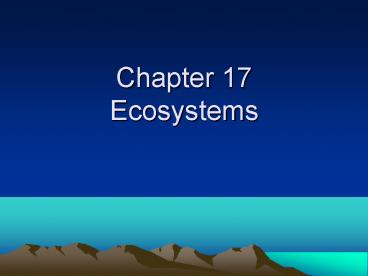Chapter 17 Ecosystems - PowerPoint PPT Presentation
1 / 35
Title:
Chapter 17 Ecosystems
Description:
Chapter 17 Ecosystems Nitrogen Cycle Living organisms cannot use Nitrogen directly from the atmosphere Nitrogen needed for proteins Plants and bacteria work together ... – PowerPoint PPT presentation
Number of Views:194
Avg rating:3.0/5.0
Title: Chapter 17 Ecosystems
1
Chapter 17Ecosystems
2
Levels of Organization
- Ecologists recognize a hierarchy of organization
in the environment biosphere, ecosystem,
community, population, and organism.
3
Levels of Organization
4
Levels of Organization, continued
- The Biosphere
- The broadest, most inclusive level of
organization is the biosphere, the volume of
Earth and its atmosphere that supports life.
5
Levels of Organization, continued
- Ecosystems
- The biosphere is composed of smaller units called
ecosystems.
- An ecosystem includes all of the organisms and
the nonliving environment found in a
particular place.
6
Levels of Organization, continued
- A community is all the interacting organisms
living in an area.
- Below the community level of organization is
the population level, where the focus is on the
individual organisms of a single species.
7
Habitat the place where a particular
population of species lives
- Biotic and Abiotic Factors
- Both biotic, or living, factors and abiotic, or
nonliving, factors influence organisms.
8
- Biodiversity
- -the number of species living within an
ecosystem - - a larger number of different species in an
area means that there is greater biodiversity
9
Boundaries
- Physical boundaries between ecosystems is not
easily defined
Is the ecosystem a whole forest, or the single
rotting log . it often depends on what is being
studied.
10
Ecosystems Change
- Over time ecosystems naturally change in a
process called succession - (Fields becoming forests, ponds fill up,etc.)
Types Primary succession occurs when no plants
have grown before Pioneer species the
first organisms to appear
11
Secondary Succession occurs when there has been
previous growth (fires, floods, earthquakes,
etc._)
See Glacier Bay example page 363
12
How Energy Moves in Ecosystems
- Everything that living things do requires energy.
- The flow of energy controls the types of
organisms that live in an ecosystem
Most life depends on photosynthetic organisms
which get their energy from the sun and produce
food (organic compounds)
13
- Producers
- -organism which capture energy
- (plants, some bacteria, and algae)
Consumers - organisms that consume plants or
other organisms to obtain energy necessary to live
14
- Trophic Level
- a group of organisms that have the same source of
energy - a specific level in a food chain
Energy moves from one trophic level to another
...
15
Energy Flow
- Food Chains and Food Webs
- A single pathway of energy transfer is a food
chain - A network showing all paths of energy transfer is
a food web
16
p. 366
17
page 367
18
page 367
19
The lowest trophic level of any ecosystem are the
producers which take energy from the sun and
build energy-rich carbohydrates
Primary consumers are next
Herbivores animals that eat plants or other
producers (must be able to break down a plants
molecules
20
The lowest trophic level of any ecosystem are the
producers which take energy from the sun and
build energy-rich carbohydrates
Primary consumers are next
Herbivores animals that eat plants or other
producers (must be able to break down a plants
molecules
21
- Carnivores - animals that eat herbivores
(meat)
Omnivores organisms that eat both plants and
animals
22
- Detritivores
- organisms that obtain their energy from the
organic wastes and dead bodies - Decomposers
- cause decay which releases nutrients back into
the soil
23
Energy Loss in ecosystems
- When energy transfers from one organism to
another a portion of it is lost (movement,
breathing, almost 50 as heat)
In fact, only 10 of energy is available to the
next level
24
- Energy Pyramids
- - the greatest biomass is at the bottom because
it supports all organisms above it.
25
- Trophic levels are limited
- Due to potential energy loss
- To determine the amount of energy present at
trophic levels, ecologists measure the biomass
(dry weight of tissue and other organic matter
found in an ecosystem.
- each higher trophic level contains only 10 of
the biomass found in the level below it
26
(No Transcript)
27
17-3 Ecosystems Cycle Materials
- Materials cycle between living and nonliving
things - Water, minerals, carbon, etc.
- Biogeochemical cycles pathways that form when a
substance enters a living organism, stays, then
returns to a nonliving environment
28
(No Transcript)
29
- Water Cycle
- - Precipitation rain, snow, sleet, hail
- - Transpiration
- Loss of water (evaporation) through leaves
- Evaporation from liquid to water vapor
in the air
30
- - Percolation when water filters through the
soil to become ground water - - Runoff
- When precipitation travels to lakes and streams
- Water Vapor the gas form of water, when it
condenses, clouds form
31
Carbon Cycle
32
- Carbon Cycle
- Photosynthesis
- Requires carbon dioxide
- Cell respiration
- Uses carbon dioxide
- Combustion
- Burning of fossil fuels returns Carbon dioxide
- Erosion
- Erosion of limestone allows carbon dioxide to
become available
33
(No Transcript)
34
- Nitrogen Cycle
- Living organisms cannot use Nitrogen directly
from the atmosphere - Nitrogen needed for proteins
- Plants and bacteria work together to make
Nitrogen available
35
- Nitrogen Fixation
- - the process of combining nitrogen with
hydrogen to form ammonia - - carried out primarily by bacteria
- the ammonia is converted to nitrates in the soil
that plants can absorb into their systems to help
them build proteins and nucleic acids































